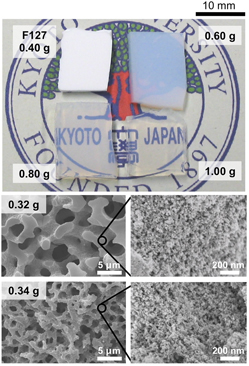Crossref Citations
This article has been cited by the following publications. This list is generated based on data provided by
Crossref.
Kanamori, Kazuyoshi
2015.
Monolithic silsesquioxane materials with well-defined pore structure – ERRATUM.
Journal of Materials Research,
Vol. 30,
Issue. 2,
p.
323.
Jiang, Chundong
Yang, Wenyan
and
Liu, Hongzhi
2016.
Hybrid azobenzene-doped nanoporous polymers derived from cubic octavinylsilsesquioxane.
Russian Chemical Bulletin,
Vol. 65,
Issue. 4,
p.
1076.
Hayase, Gen
Kanamori, Kazuyoshi
Maeno, Ayaka
Kaji, Hironori
and
Nakanishi, Kazuki
2016.
Dynamic spring-back behavior in evaporative drying of polymethylsilsesquioxane monolithic gels for low-density transparent thermal superinsulators.
Journal of Non-Crystalline Solids,
Vol. 434,
Issue. ,
p.
115.
Aoki, Yosuke
Shimizu, Taiyo
Kanamori, Kazuyoshi
Maeno, Ayaka
Kaji, Hironori
and
Nakanishi, Kazuki
2017.
Low-density, transparent aerogels and xerogels based on hexylene-bridged polysilsesquioxane with bendability.
Journal of Sol-Gel Science and Technology,
Vol. 81,
Issue. 1,
p.
42.
Shimizu, Taiyo
Kanamori, Kazuyoshi
and
Nakanishi, Kazuki
2017.
Transparent polyvinylsilsesquioxane aerogels: investigations on synthetic parameters and surface modification.
Journal of Sol-Gel Science and Technology,
Vol. 82,
Issue. 1,
p.
2.
Shimizu, Taiyo
Kanamori, Kazuyoshi
and
Nakanishi, Kazuki
2017.
Silicone‐Based Organic–Inorganic Hybrid Aerogels and Xerogels.
Chemistry – A European Journal,
Vol. 23,
Issue. 22,
p.
5176.
Nakanishi, Kazuki
Kanamori, Kazuyoshi
Tokudome, Yasuaki
Hasegawa, George
and
Zhu, Yang
2017.
Handbook of Solid State Chemistry.
p.
195.
Yu, Xiaoxiao
Yu, Ruobing
Li, Qianqian
and
Jiao, Zheng
2017.
Porous aromatic frameworks of co-cured diethynylbenzene (DEB) and vinyltrimethoxysilane (VTMS) with good thermo-oxidative stability.
Iranian Polymer Journal,
Vol. 26,
Issue. 6,
p.
413.
Lei, Chaoshuai
Li, Junning
Sun, Chencheng
Yang, Hailong
Xia, Tao
Hu, Zijun
and
Zhang, Yue
2018.
Transparent, elastic and crack-free polymethylsilsesquioxane aerogels prepared by controllable shrinkage of the hydrogels in the aging process.
Microporous and Mesoporous Materials,
Vol. 267,
Issue. ,
p.
107.
Lei, Chaoshuai
Li, Junning
Sun, Chencheng
Yang, Hailong
Xia, Tao
Hu, Zijun
and
Zhang, Yue
2018.
A Co-Precursor Approach Coupled with a Supercritical Modification Method for Constructing Highly Transparent and Superhydrophobic Polymethylsilsesquioxane Aerogels.
Molecules,
Vol. 23,
Issue. 4,
p.
797.
Niu, Ziwei
He, Xiaoyong
Huang, Teng
Tang, Bicheng
Cheng, Xuan
Zhang, Ying
and
Shao, Zaidong
2019.
A facile preparation of transparent methyltriethoxysilane based silica xerogel monoliths at ambient pressure drying.
Microporous and Mesoporous Materials,
Vol. 286,
Issue. ,
p.
98.
Li, Hongwei
Lu, Liangyu
Xiong, Yuzhu
and
Dong, Fuping
2019.
Uniform and reactive hydrogen polysilsesquioxane hollow spheres immobilized with silver nanoparticles for catalytic reduction of methylene blue.
Applied Surface Science,
Vol. 493,
Issue. ,
p.
897.
Satoh, Yasushi
Fuchise, Keita
Nozawa, Takeshi
Sato, Kazuhiko
and
Igarashi, Masayasu
2020.
A catalyst- and additive-free synthesis of alkoxyhydrosiloxanes from silanols and alkoxyhydrosilanes.
Chemical Communications,
Vol. 56,
Issue. 59,
p.
8218.
Hu, Nai-hsuan
Lenora, Chamika U.
May, Timothy A.
Hershberger, Nathan C.
and
Furgal, Joseph C.
2020.
In situ formed methyl-co-(bis-R) silsesquioxane based polymer networks with solvent controlled pore size distributions and high surface areas.
Materials Chemistry Frontiers,
Vol. 4,
Issue. 3,
p.
851.
Kim, Changwook
Ryu, Yunha
Shin, Dongheok
Urbas, Augustine M.
and
Kim, Kyoungsik
2020.
Efficient solar steam generation by using metal-versatile hierarchical nanostructures for nickel and gold with aerogel insulator.
Applied Surface Science,
Vol. 517,
Issue. ,
p.
146177.
Hu, Nai-hsuan
and
Furgal, Joseph C.
2020.
R-Silsesquioxane-Based Network Polymers by Fluoride Catalyzed Synthesis: An Investigation of Cross-Linker Structure and Its Influence on Porosity.
Materials,
Vol. 13,
Issue. 8,
p.
1849.
Sakuma, Wataru
Yamasaki, Shunsuke
Fujisawa, Shuji
Kodama, Takashi
Shiomi, Junichiro
Kanamori, Kazuyoshi
and
Saito, Tsuguyuki
2021.
Mechanically Strong, Scalable, Mesoporous Xerogels of Nanocellulose Featuring Light Permeability, Thermal Insulation, and Flame Self-Extinction.
ACS Nano,
Vol. 15,
Issue. 1,
p.
1436.
Dawson, Harry
Elias, Jinane
Etienne, Pascal
and
Calas-Etienne, Sylvie
2021.
The Rise of the OM-LoC: Opto-Microfluidic Enabled Lab-on-Chip.
Micromachines,
Vol. 12,
Issue. 12,
p.
1467.
Zhang, Guang-Lei
Shi, Xin-Yue
Qin, Sheng-Jian
Qin, Guo-Qiang
Wu, Hong-Ya
Duan, Yi-Fan
and
Zhang, Guang-Tian
2021.
The roles of density and oxygen concentration on the structure of silica aerogel: Insight from an atomistic study.
Journal of Non-Crystalline Solids,
Vol. 556,
Issue. ,
p.
120666.
Nozawa, Takeshi
Kobayashi, Toshiaki
Matsumoto, Tomohiro
Yagihashi, Fujio
Sato, Kazuhiko
and
Igarashi, Masayasu
2021.
Treating octasilanol [Si8O12][OH]8 with tetramethoxysilane and trimethoxyvinylsilane: a halogen-free synthetic route to alkoxysilyl-substituted double-four-ring siloxanes.
Dalton Transactions,
Vol. 50,
Issue. 5,
p.
1594.
